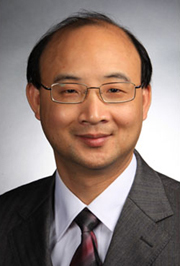
Could you tell us about the work you do providing training to young researchers? What does this involve, and what are the aims?
There are several things that I regularly do to help young faculty members and researchers in the same department as me, or even in other departments of the school, to progress from a junior to a senior researcher.
Firstly, I analyze and discuss their research with them and compare it to other current research published in the literature. Secondly, I provide them with the chance to input on some of the articles that I write as I like to offer writing opportunities to them. And thirdly, for journals where I am involved in the editorial process, I send them manuscripts to peer review based on their expertise.
What feedback, if any, have you received from the students involved with the programmes you have implemented?
I have 50 students who work in my and my collaborators’ labs. I instruct them and we conduct research together, but I don’t have a formal programme for receiving feedback for this. From time to time I’m told that the students love the opportunities to review manuscripts and to critically discuss their research in comparison with other published research.
They have also mentioned several times that they would like to attend training courses, such as author workshops, provided by journal publishers that include talks from senior experienced scientists who publish or review manuscripts a lot. These offer students the chance to learn more skills, such as improving their writing and journal editing, understanding the peer review system, and of course also improving their critical reading skills.
What do you think are the most important steps in producing high quality research and ensuring this is, in turn, published in high quality journals?
I think first of all, the number one thing is always the scientific or clinical significance, and the novelty of the research questions picked out to study. So I think all researchers including junior and even senior researchers, always have to learn how to choose the best question to study.
Second of course is the training issue and whether we are trained in the lab to implement good research design and to perform research in a proper way, including experimental skills, and so on and so forth.
And thirdly, after you have the research question, you have designed the research, carried out the experiment, and collected all the data, comes the writing of the paper. One of the most important things to think about when you come to write a paper is to identify a really good central theme.
It is very important to choose an angle when writing your paper because the same set of data can be written up it in very different ways. You have to analyze and find out what your selling point is, and that, of course, requires lots of experience. Your understanding of the journals you are targeting I think is also a very important thing.
In your opinion, what aspects of a journal do you think are indicators of its quality that should be considered when deciding where to submit your research?

I think a universal question that you always have to answer is: what journal is a good fit for the particular research that you’re trying to publish? In general I think that a good quality journal means to me three things:
The first is the reputation of the journal, particularly within community of scientists in that particular field. When I was a student and when I was a post doc I looked for journals that published authors who also published frequently in top journals.
Second, I would read the journal very carefully and get an idea of the quality of the papers published in that journal.
Last, you can never stay away from the impact factor of the journal. But what I would like to underscore is that the impact factor is definitely not the number one thing, and it is definitely not the only thing we should consider when deciding where to publish.
I think for me, before I would choose a journal, I would imagine what the readership of my paper would be. So for some manuscripts I would like more biological sciences people to read it, or sometimes the more medical or clinical people to read it, so knowing this helps you to choose between journals.
Peer review is an important process in ensuring a journal publishes sound research. How important do you feel it is to engage young researchers in this process and why is this?
I think it is very, very important. I don’t think anyone can turn into a mature, successful researcher without peer reviewing journal manuscripts. It is a very important experience that a young investigator or researcher has to gain during their growth into a more successful scientist.
It helps young researchers to gain an insight into good papers and to judge what makes a paper good.
It is also a good way for young researchers to sensitize themselves to common or uncommon flaws. Because when they look at other people’s manuscripts, if they can find the flaws and mistakes the other authors have made in their experiments or in their writing, these mistakes can be avoided in the young researcher’s own work when they come to write a paper.
Another reason for the importance of peer reviewing as a young researcher is that it is very good for practicing writing skills because you have to carefully examine other people’s work and provide critique on it. It also helps the young researcher to understand the editing and publishing process.
Finally, you have experience of working in both China and the US. What in your opinion are the differences, if any, in the research culture in both countries? For example, can researchers based in the US learn anything from the researchers based in China, and vice versa?
I think in China more people enter the field of academia before they have a chance to think about, or try, other options.
There are many differences between the research cultures in the two countries.
First, one thing I think junior researchers in China can learn from the researchers based in US is the passion for science and the subjects one is working within. You will see more passion demonstrated in the US junior researchers who pursue careers in science, and you see more curiosity driven young researchers than the number you can see in China.
And this has a lot to do with the differences in the education systems in the two countries. I think in China more people enter the field of academia before they have a chance to think about, or try, other options. I think for the researchers in China, this is something that we should pay more attention to.
The second thing is that I think researchers in China should pay more attention to learning how to pick up important questions to study and to spend their very valuable time, energy and wisdom on. I think you can see such training is more emphasized in the US than it is in China where graduate students, post docs, and faculties tend to put more emphasis on quick data collection and a larger number of publications.
Also, for Chinese researchers, more active and extended reading is needed. And this is something I observed could be a problem for many young people in academic communities in China.
One thing I think can be learned from the Chinese young scholars is that even between different labs, or different institutions, they actively communicate and interact with each other. Through these lines of communication they have created many channels to exchange research methods and technologies.
When I did my post doc at Pittsburgh Cancer Institute, USA, we didn’t really talk too much with other labs, but in China it is a very common practice. Young people need to communicate with each other and help each other technically and scientifically, so they can learn from their peers.
Comments